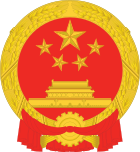National Development and Reform Commission
中华人民共和国国家发展和改革委员会 Zhōnghuá Rénmín Gònghéguó Guójiā Fāzhǎn hé Gǎigé Wěiyuánhuì | |
 Emblem of the People's Republic of China | |
| Agency overview | |
|---|---|
| Formed | March, 2003 |
| Preceding agencies |
|
| Type | Cabinet-level Department Constituting the State Council |
| Jurisdiction | |
| Headquarters | Beijing |
| Employees | 890 |
| Agency executive |
|
| Parent agency | State Council |
| Website | www.ndrc.gov.cn[1] |
| National Development and Reform Commission | |||||||
| Simplified Chinese | 国家发展和改革委员会 | ||||||
|---|---|---|---|---|---|---|---|
| Literal meaning | State Development and Reform Commission | ||||||
| |||||||
| Commonly abbreviated as | |||||||
| Simplified Chinese | 发改委 | ||||||
| Literal meaning | Develop-Reform-Commission | ||||||
| |||||||
| This article is part of a series on the |
| Politics of China |
|---|
 |
Leadership
|
Communist Party
|
United Front
|
Ideology
|
|
Legislative
|
Presidency
|
Executive
|
Military
|
Supervision
|
|
Publicity
|
|
Cross-Strait relations
|
Foreign relations
|
Related topics
|
|
The National Development and Reform Commission of the People's Republic of China (NDRC), formerly State Planning Commission and State Development Planning Commission, is a macroeconomic management agency under the Chinese State Council, which has broad administrative and planning control over the Chinese economy. The candidate for the chairperson of the NDRC is nominated by the Premier of the People's Republic of China and approved by the National People's Congress. Since February 2017 the Commission has been headed by He Lifeng.
The NDRC's functions are to study and formulate policies for economic and social development, maintain the balance of economic development, and to guide restructuring of China's economic system.[1] The NDRC has twenty-six functional departments/bureaus/offices with an authorized staff size of 890 civil servants.
Contents
1 List of chairmen
2 Current Leadership
3 National Energy Administration
4 See also
5 References
6 External links
List of chairmen
| № | Name | Took office | Left office | Premier |
|---|---|---|---|---|
| 1 | Gao Gang | November 1952 | August 1954 | Independent of the Premier |
| 2 | Li Fuchun | September 1954 | January 1975 | Zhou Enlai |
| 3 | Yu Qiuli | January 1975 | August 1980 | Zhou Enlai Hua Guofeng |
| 4 | Yao Yilin | August 1980 | June 1983 | Zhao Ziyang |
| 5 | Song Ping | June 1983 | June 1987 | Zhao Ziyang |
| 6 | Yao Yilin | June 1987 | December 1989 | Zhao Ziyang Li Peng |
| 7 | Zou Jiahua | December 1989 | March 1993 | Li Peng |
| 8 | Chen Jinhua | March 1993 | March 1998 | Li Peng |
| 9 | Zeng Peiyan | March 1998 | March 2003 | Zhu Rongji |
| 10 | Ma Kai | March 2003 | March 2008 | Wen Jiabao |
| 11 | Zhang Ping | March 2008 | 16 March 2013 | Wen Jiabao |
| 12 | Xu Shaoshi | 16 March 2013 | 24 February 2017 | Li Keqiang |
| 13 | He Lifeng | 24 February 2017 | Incumbent | Li Keqiang |
Current Leadership
- Chairman
He Lifeng - Vice Chairman of the CPPCC National Committee (sub-state level national leader)
- Vice Chairmen
Zhang Yong - Minister level
Ning Jizhe - Minister level
Mu Hong - Minister level, Deputy General Office chief of the Central Leading Group for Comprehensively Deepening Reforms
Lian Weiliang (连维良)
Liu Xiaobin (刘晓滨)
Lin Nianxiu (林念修)
Hu Zucai (胡祖才)
Wang Xiaotao (王晓涛)[1]
National Energy Administration
NEA was established in August 2008, replacing the National Energy Bureau (NEB; 国家能源局) which attempted to reform China’s highly dispersed energy management.[2]
See also
- China Compulsory Certificate
- Economy of China
- Energy in China (category)
- Gosplan
- Number 10 Policy Unit
- State Information Center
References
^ abc www.ndrc.gov.cn
^ Highlights of China's institutional restructuring plan - china.org.cn
External links
- Official site

